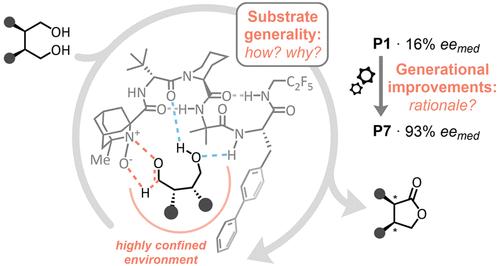一般氨基基氧化催化剂的实验谱系和计算分析:从底物特异性相互作用的普遍性
IF 13.1
1区 化学
Q1 CHEMISTRY, PHYSICAL
引用次数: 0
摘要
传统上,不对称催化中的催化剂优化是一个迭代的、基于启发式的过程,在这个过程中,针对一个(或少数)模型底物测试命中催化剂的点修改。虽然优化到高水平的选择性有时是成功的,但催化剂在底物范围方面的通用性(即,其提供具有一贯高水平选择性的多种目标产品的能力)更加难以捉摸。这项工作描述并模拟了一个成功的肽催化剂优化运动,该运动在可验证的多种底物上进行,提供了高选择性和通用的手性催化剂。催化剂设计的每一代改进的成功现在都是通过对单个衬底的从头算建模的原子分辨率来合理化的,这些衬底主要受益于这一代的改进。对协调催化剂构象和底物-催化剂相互作用的非共价相互作用网络的结构和拓扑进行了剖析,最终确定了优化催化剂的普遍性。令人惊讶和重要的是,许多底物的高选择性的普遍性被发现与替代的,实际上是底物特异性的相互作用一致,这表明功能的普遍性不一定是机制同源性的结果。本文章由计算机程序翻译,如有差异,请以英文原文为准。

Experimental Lineage and Computational Analysis of a General Aminoxyl-Based Oxidation Catalyst: Generality from Substrate-Specific Interactions
Traditionally, catalyst optimization in asymmetric catalysis is approached as an iterative, heuristic-based process, where point modifications of a hit catalyst are tested against one (or a small number of) model substrate(s). While optimization to high levels of selectivity is sometimes successful, catalyst generality with respect to substrate scope (i.e., its ability to deliver a diverse set of target products with consistently high levels of selectivity) is more elusive. This work describes and models computationally a successful peptide catalyst optimization campaign carried out on a verifiably diverse set of substrates, which delivered a highly selective and general chiral catalyst. The success of every generational improvement of the catalyst design is now rationalized with atomistic resolution by ab initio modeling of the individual substrate that mostly benefits from that generational improvement. Structural and topological insights about the noncovalent interaction networks orchestrating both the catalyst conformation and the substrate–catalyst interactions were dissected, culminating on the underpinnings of the optimized catalyst’s generality. Surprisingly and significantly, the generality of high selectivity for many substrates was found to be consistent with alternative, and indeed substrate-specific, interactions, suggesting that functional generality need not be a result of mechanistic homology.
求助全文
通过发布文献求助,成功后即可免费获取论文全文。
去求助
来源期刊

ACS Catalysis
CHEMISTRY, PHYSICAL-
CiteScore
20.80
自引率
6.20%
发文量
1253
审稿时长
1.5 months
期刊介绍:
ACS Catalysis is an esteemed journal that publishes original research in the fields of heterogeneous catalysis, molecular catalysis, and biocatalysis. It offers broad coverage across diverse areas such as life sciences, organometallics and synthesis, photochemistry and electrochemistry, drug discovery and synthesis, materials science, environmental protection, polymer discovery and synthesis, and energy and fuels.
The scope of the journal is to showcase innovative work in various aspects of catalysis. This includes new reactions and novel synthetic approaches utilizing known catalysts, the discovery or modification of new catalysts, elucidation of catalytic mechanisms through cutting-edge investigations, practical enhancements of existing processes, as well as conceptual advances in the field. Contributions to ACS Catalysis can encompass both experimental and theoretical research focused on catalytic molecules, macromolecules, and materials that exhibit catalytic turnover.
 求助内容:
求助内容: 应助结果提醒方式:
应助结果提醒方式:


